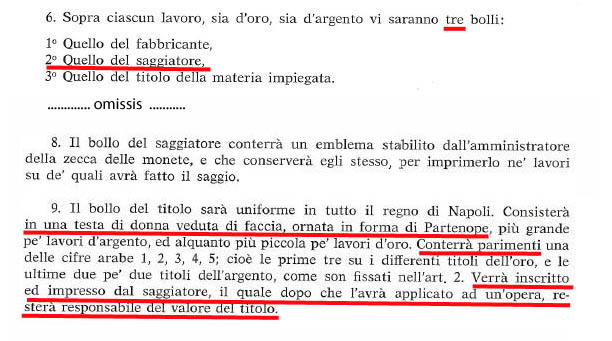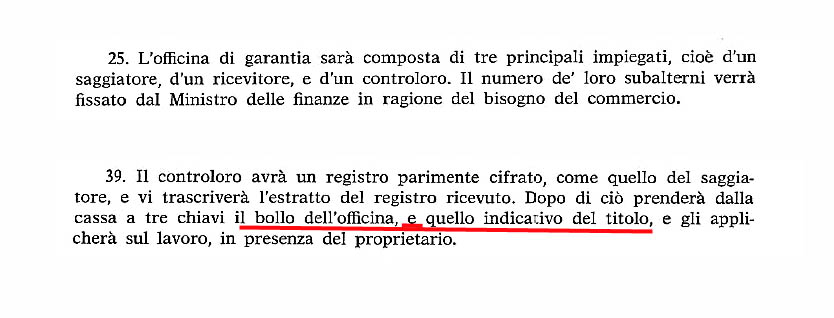Well, after digging deeper, here I am trying to explain what I found.
It's not easy to do it even in Italian, let alone in English.
The first thing that catches the eye is that the law contradicts itself

In articles 6,8 and 9 we read
6. On each work, both gold and silver, there will be three marks:
1st that of the manufacturer,
2nd That of the assayer,
3rd That of the fineness of the material used.
8. The assayer's mark will contain an emblem established by the administrator of the coin mint, and which he will keep himself, to imprint it on the works on which he will have done the test.
9. The fineness mark will be uniform throughout the kingdom of Naples. It will consist of a woman's head seen from the face, decorated in the form of a Parthenope, larger for the silver works, and somewhat smaller for the gold works. It will also contain one of the Arabic numerals 1, 2, 3, 4, 5; that is, the first three for the different gold finenesses, and the last two for the two silver finenesses, as set forth in art. 2. It will be inscribed and impressed by the assayer, who after having applied it to a work, will remain responsible for the value of the fineness.
Here therefore it is clear that the third mark, the one of the fineness, will be the head of Partenope which must
also contain the figure relating to the fineness and must be struck by the assayer.
However, later, in article 39 we read
 25. The guarantee office will be composed of three main employees, namely an assayer, a receiver, and a controller. The number of their subordinates will be fixed by the Minister of Finance according to the needs of the trade.
25. The guarantee office will be composed of three main employees, namely an assayer, a receiver, and a controller. The number of their subordinates will be fixed by the Minister of Finance according to the needs of the trade.
39. The controller will have a register, also stamped, like that of the assayer, and will transcribe the extract from the register received. After that he will take the office punch and the one indicative of the fineness from the box with three keys and apply them to the work, in the presence of the owner.
Here, therefore, the mark of the guarantee office and the one indicative of the fineness are said to be
two different punches, which are applied by the controller.
This is the law, in practice instead, as Catello himself tells us on page 112 of his book, the assayer's mark was never adopted.
It must also be said that there are Parthenope heads of various sizes and designs, and I have not found an explanation for this in the literature
Below are some examples









